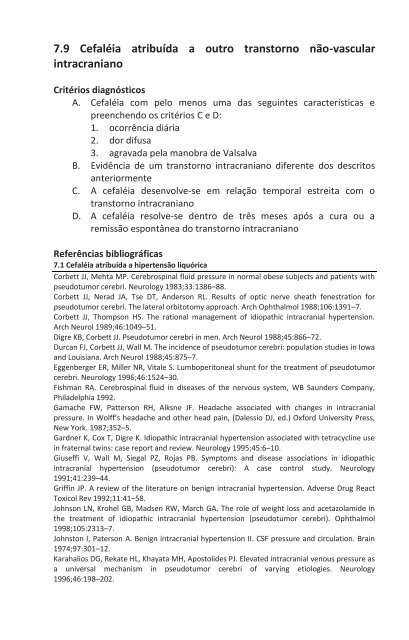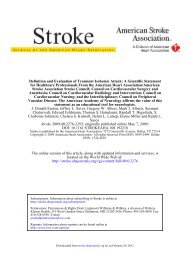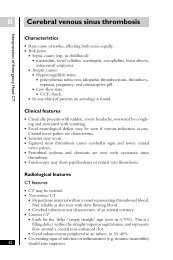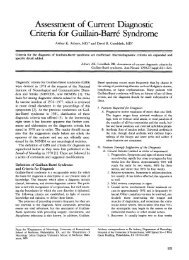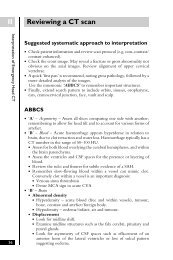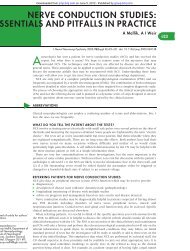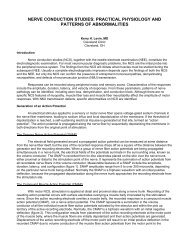Classificação Internacional das Cefaléias - HGF – Neurologia
Classificação Internacional das Cefaléias - HGF – Neurologia
Classificação Internacional das Cefaléias - HGF – Neurologia
You also want an ePaper? Increase the reach of your titles
YUMPU automatically turns print PDFs into web optimized ePapers that Google loves.
7.9 Cefaléia atribuída a outro transtorno não-vascular<br />
intracraniano<br />
Critérios diagnósticos<br />
A. Cefaléia com pelo menos uma <strong>das</strong> seguintes características e<br />
preenchendo os critérios C e D:<br />
1. ocorrência diária<br />
2. dor difusa<br />
3. agravada pela manobra de Valsalva<br />
B. Evidência de um transtorno intracraniano diferente dos descritos<br />
anteriormente<br />
C. A cefaléia desenvolve-se em relação temporal estreita com o<br />
transtorno intracraniano<br />
D. A cefaléia resolve-se dentro de três meses após a cura ou a<br />
remissão espontânea do transtorno intracraniano<br />
Referências bibliográficas<br />
7.1 Cefaléia atribuída a hipertensão liquórica<br />
Corbett JJ, Mehta MP. Cerebrospinal fluid pressure in normal obese subjects and patients with<br />
pseudotumor cerebri. Neurology 1983;33:1386<strong>–</strong>88.<br />
Corbett JJ, Nerad JA, Tse DT, Anderson RL. Results of optic nerve sheath fenestration for<br />
pseudotumor cerebri. The lateral orbitotomy approach. Arch Ophthalmol 1988;106:1391<strong>–</strong>7.<br />
Corbett JJ, Thompson HS. The rational management of idiopathic intracranial hypertension.<br />
Arch Neurol 1989;46:1049<strong>–</strong>51.<br />
Digre KB, Corbett JJ. Pseudotumor cerebri in men. Arch Neurol 1988;45:866<strong>–</strong>72.<br />
Durcan FJ, Corbett JJ, Wall M. The incidence of pseudotumor cerebri: population studies in Iowa<br />
and Louisiana. Arch Neurol 1988;45:875<strong>–</strong>7.<br />
Eggenberger ER, Miller NR, Vitale S. Lumboperitoneal shunt for the treatment of pseudotumor<br />
cerebri. Neurology 1996;46:1524<strong>–</strong>30.<br />
Fishman RA. Cerebrospinal fluid in diseases of the nervous system, WB Saunders Company,<br />
Philadelphia 1992.<br />
Gamache FW, Patterson RH, Alksne JF. Headache associated with changes in intracranial<br />
pressure. In Wolff’s headache and other head pain, (Dalessio DJ, ed.) Oxford University Press,<br />
New York. 1987;352<strong>–</strong>5.<br />
Gardner K, Cox T, Digre K. Idiopathic intracranial hypertension associated with tetracycline use<br />
in fraternal twins: case report and review. Neurology 1995;45:6<strong>–</strong>10.<br />
Giuseffi V, Wall M, Siegal PZ, Rojas PB. Symptoms and disease associations in idiopathic<br />
intracranial hypertension (pseudotumor cerebri): A case control study. Neurology<br />
1991;41:239<strong>–</strong>44.<br />
Griffin JP. A review of the literature on benign intracranial hypertension. Adverse Drug React<br />
Toxicol Rev 1992;11:41<strong>–</strong>58.<br />
Johnson LN, Krohel GB, Madsen RW, March GA. The role of weight loss and acetazolamide in<br />
the treatment of idiopathic intracranial hypertension (pseudotumor cerebri). Ophthalmol<br />
1998;105:2313<strong>–</strong>7.<br />
Johnston I, Paterson A. Benign intracranial hypertension II. CSF pressure and circulation. Brain<br />
1974;97:301<strong>–</strong>12.<br />
Karahalios DG, Rekate HL, Khayata MH, Apostolides PJ. Elevated intracranial venous pressure as<br />
a universal mechanism in pseudotumor cerebri of varying etiologies. Neurology<br />
1996;46:198<strong>–</strong>202.


